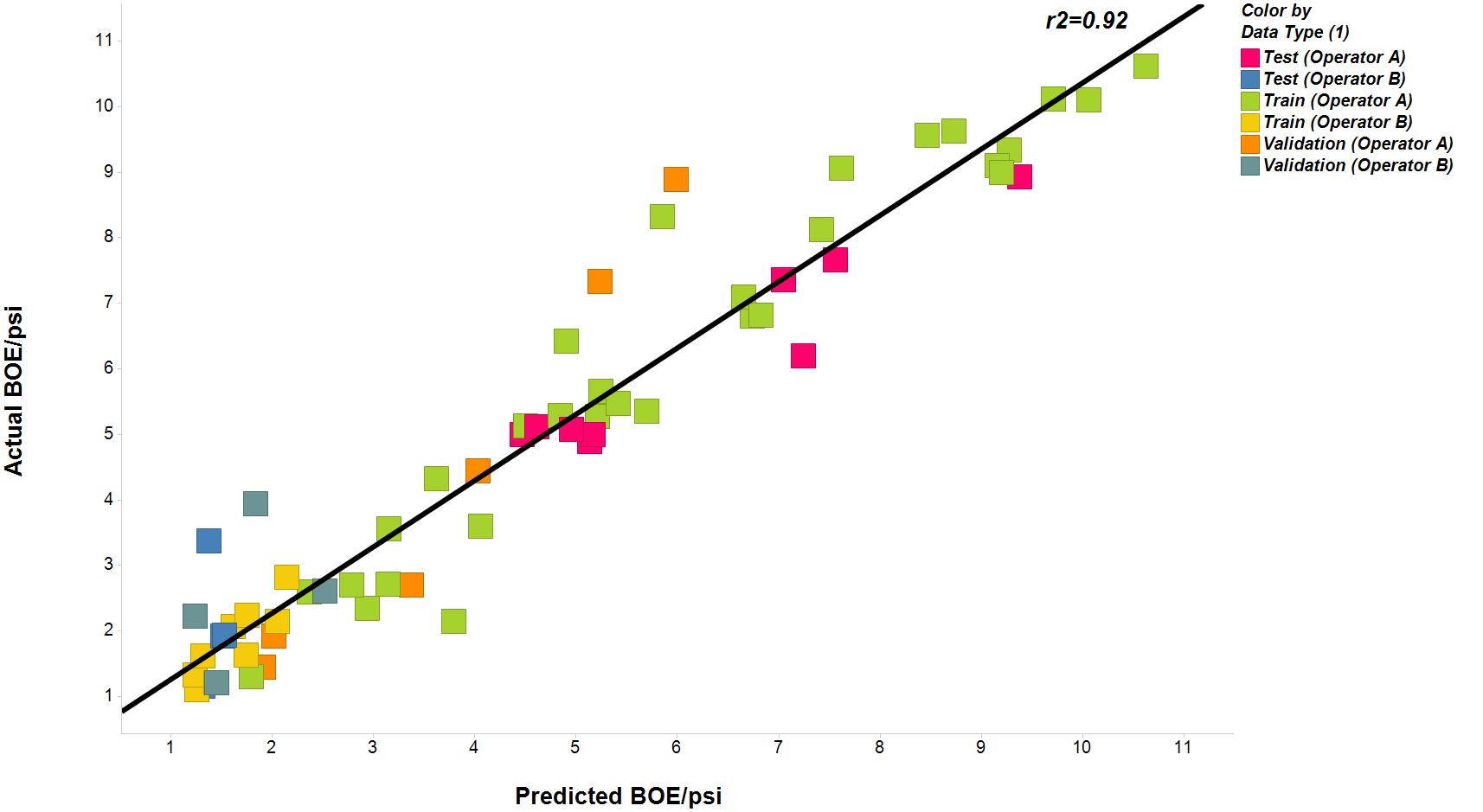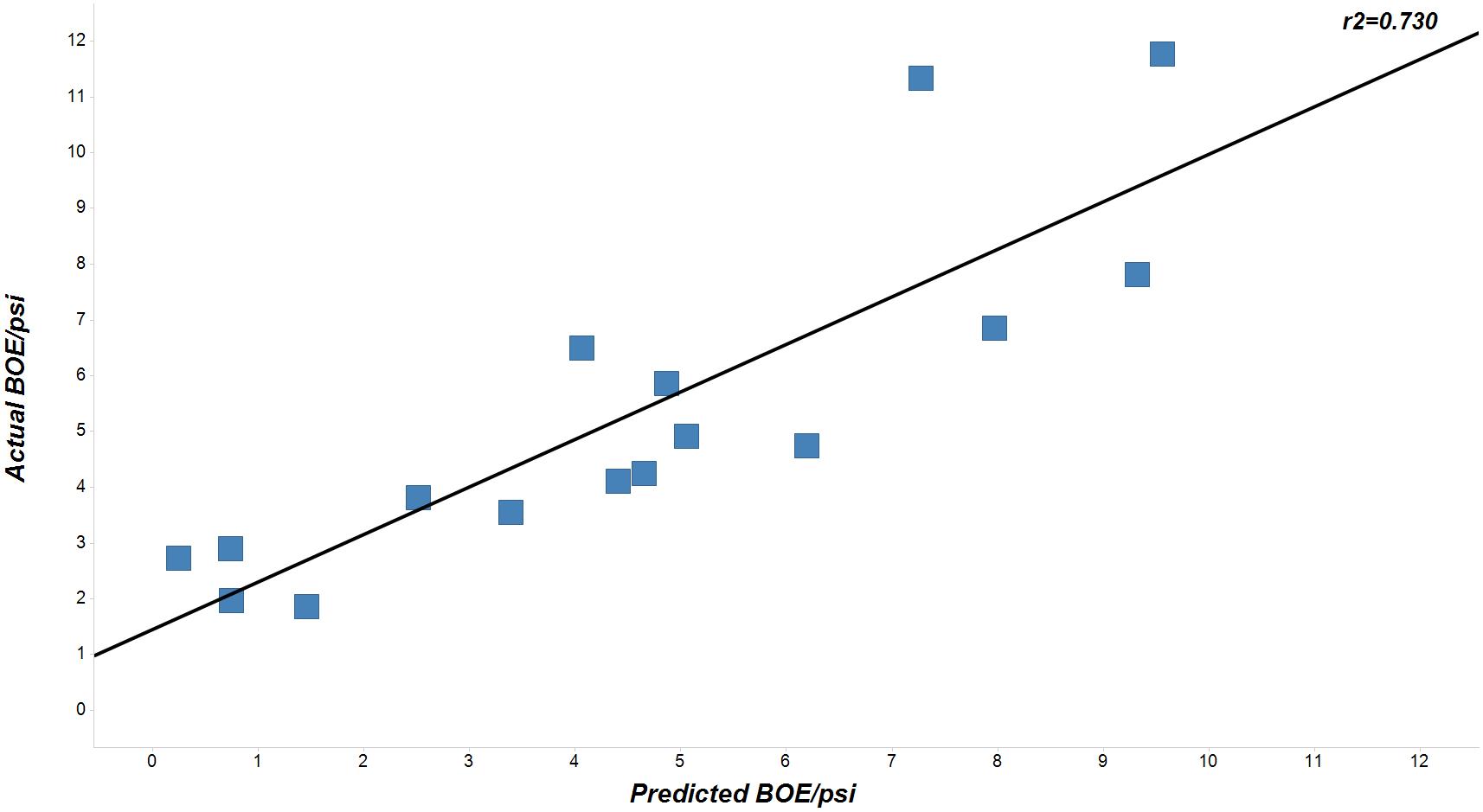A data-driven neural network model, built upon an evaluation of integrated, multi-operator datasets, yields deeper insight for optimizing area-specific completion and fracture treatment designs aimed at maximizing production and reducing costs throughout the multiple-hydrocarbon-window Eagle Ford Shale.
The validated model addresses the unique challenges in designing fracture stimulation jobs in a play, which along with localized variations in thickness, thermal maturity and pore pressure features diverse reservoir fluid types. The indexed well performance analysis can be used to identify key production drivers specific to the heterogeneous geological and petrophysical characteristics of the Eagle Ford. The proppant-centric data are correlated into the most effective completion and stimulation strategies for maximizing return on investment (ROI), from the sweet spot to the more marginal areas within the South Texas play.
Trained on a comprehensive database, the artificial neural network (ANN) model identifies the cause-and-effect relationships of various completion- and fracturerelated inputs as well as readily obtainable drilling and mud data used to indicate pressure, fluid saturation, permeability and other geological and reservoir-related parameters. The model outputs, comprising normalized oil and gas production to account for pressure management differences, on the whole delivered predicted and observed best 30-day well productivity values greater than 0.9 for boe/psi, 0.8 for bbl/psi and 0.85 for Mcf/psi.
Specifically, sensitivity analysis of the ANN model isolated the top of the Eagle Ford from sea level as the most important noncontrollable reservoir-related parameter, followed by the butane and pentane fraction measured during horizontal drilling. Further, the model holds that deeper wells, with their comparatively better reservoir characteristics and higher thermal maturity, tend to produce more hydrocarbons. The model also holds that those completed with optimized fracture stimulation programs, which couple additional frack stages to enhance reservoir contact with high-conductivity frack designs, also produce more hydrocarbons.
The model, while reinforcing the compelling correlation between pounds of proppant pumped and 90-day oil production, supports the dual hypothesis that large-volume sand treatments generally increase costs and inefficiencies and that the contribution of 100-mesh sand proppant to oil production is negligible.



Building the model
Typically, in comparatively homogeneous reservoirs, a discrete single-well modeling approach in which numerical reservoir models are constructed based on available data is used to evaluate the productive capacity of completions and stimulations. However, the extreme geological complexities of most unconventional plays like the Eagle Ford usually prevent this conventional methodology from analyzing a wide range of wells and, in turn, produce both general and field-specific recommendations on completion effectiveness.
By definition, the neural network modeling technique used in the Eagle Ford evaluation analyzed diverse well datasets to identify connections between the system input and output variables. The technique sought to do so without requiring explicit knowledge of the physical behavior of the system. Owing to its flexibility, neural network modeling can handle a large number of datasets to produce high-level analysis. Therefore, it offers an inherent advantage in that models are built based on available data, making prior assumptions and/or knowledge of input data unnecessary.
The Eagle Ford study utilized a database comprising 81 wells completed by three operators (A, B and C) from 2011 to 2014 in different areas of the oil, gas and condensate windows. In building the neural network, a cumulative 39 wells completed by operators A and B were randomly selected from the database for model training as they exhibited wide production variability, from 1 boe/psi to 11 boe/psi (best 30-day cumulative equivalent barrel of oil production per psi of average drawdown). An additional 23 wells were held back from model training as test sets for model selection and validation purposes. After the neural network model was developed and tested, Operator C’s 19-well dataset was used for final model validation.
Within the database, 45 wells were attributed to Operator A, all drilled in the sweet spot fairway in Gonzales, Karnes and Atascosa counties. Excluding two wells using ceramic proppant tail-in, these wells were completed mainly with white sand proppant in a hybrid fluid system with 16 stages.
Operator C, meanwhile, contributed 17 wells to the database, which were drilled and completed in less favorable areas of Frio and Atascosa counties. On average, these wells consisted of 17 treatment stages using crosslinked gel and 30/50 white sand proppant, with two completed wells with ceramic proppant.
Operator C’s wells were all drilled in a more marginally productive area in McMullen County. Unlike its two counterparts, this operator experimented with different proppant types, with various combinations of 30/50 ceramic, 100-mesh sand and 40/70-mesh sand in a hybrid fluid system, thereby generating an average sand-to-ceramic ratio of 70% to 30%, referred to as the standard ceramic completion. Operator C completed 10 wells with 40% of the total treatment program using ceramic proppant; three wells were completed with more than 60% of the treatment proppant comprising in excess of 8 million lb of 100-mesh white sand. Since this operator’s wells were located in a less productive area compared to those of Operator A, 50% more proppant was required to achieve the same well productivity.

Comparative frack analysis
Evaluation of Operator C’s validation wells bolstered the productivity advantages of combining high-conductivity frack designs with increased reservoir contact. The evaluation showed wells stimulated entirely with white sand proppant are cost-neutral compared with those stimulated with the standard ceramic completion design, even with more proppant and additional stages. The proposed improved ceramic completion design implies performing more individual hydraulic fracture treatments per well as compared to the standard ceramic design with an estimated fracture treatment cost increase of 25% per well. Further modeling suggested that the improved ceramic proppant frack design could have provided up to 75% more productivity compared to the large volume all-white-sand completion design.
The productivity ramifications were clearly illustrated in an evaluation of one well completed in 27 stages with a combination of more than 14 million lb of 100-mesh and 40/70 sand proppant placed in 11 million gal of fracturing fluid. This well achieved actual productivity of 6.7 boe/psi, while the predictive data-driven model estimated that if the well had been completed with the standard ceramic completion design, the productivity value would have remained about the same, at 6.6 boe/psi with fewer stages and smaller volume jobs. Taking it further, if this well had been completed using an enhanced completion strategy with 28 frack stages, 5.5 million lb of sand and 4 million lb of ceramic proppant, the neural network model forecasted its productivity value increasing more than 40% to 9.6 boe/psi.
Additional reinforcement of the model output was reflected in a comparative analysis of another Operator C well completed in 26 fracture stages with 14 million lb of 100-mesh and 40/70 sand, resulting in a well productivity of 7.2 boe/psi. The neural network model estimates that employing the standard 22-stage ceramic completion design would result in a well productivity of 6.4 boe/psi. However, the improved 28-stage ceramic completion design would yield a forecasted 8.6 boe/psi productivity for this particular well.
A third well evaluated was completed with 33 stages and also used large-volume (17 million lb) 100-mesh and 40/70 mesh sand frack designs. This well produced a below-average 5.48 boe/psi, and the neural network model estimated that a standard ceramic completion design would have boosted productivity to 7.1 boe/psi while the improved high-conductivity ceramic proppant completion design would have yielded well productivity of 9.4 boe/psi.
Hence, the neural network model, while identifying under-producing wells, provides operators with data-driven recommendations for alternate and fracture stimulation designs that will elevate productivity and improve economics. This type of modeling approach can be performed with limited or vast amounts of data; the results are equally useful for emerging and more mature plays like the Eagle Ford.
Acknowledgment
This article was adapted from SPE paper 173336, “A Case History: Evaluating Well Completions in the Eagle Ford Shale Using a Data-Driven Approach,” by Amir M. Nejad, Ph.D., Stanislav Sheludko and Robert F. Shelly, P.E., of StrataGen; and Trey Hodgson and Riley McFall of Sundance Energy. The paper was presented at the 2015 SPE Hydraulic Fracturing Technology Conference in The Woodlands, Texas, from Feb. 3 to 5.
Recommended Reading
AI-Shale Synergy: Experts Detail Transformational Ops Improvements
2025-01-17 - An abundance of data enables automation that saves time, cuts waste, speeds decision-making and sweetens the bottom line. Of course, there are challenges.
Understanding the Impact of AI and Machine Learning on Operations
2024-12-24 - Advanced digital technologies are irrevocably changing the oil and gas industry.
Afterthought to Asset: How Data has Transformed Oil, Gas Decision-Making
2024-12-05 - Digital data points have transformed from a byproduct of operations to the main driver of innovation in the energy industry, says Fabricio Sousa, president of Worley Consulting.
Small Steps: The Continuous Journey of Drilling Automation
2024-12-26 - Incremental improvements in drilling technology lead to significant advancements.
Momentum AI’s Neural Networks Find the Signal in All That Drilling Noise
2025-02-11 - Oklahoma-based Momentum AI says its model helps drillers avoid fracture-driven interactions.
Comments
Add new comment
This conversation is moderated according to Hart Energy community rules. Please read the rules before joining the discussion. If you’re experiencing any technical problems, please contact our customer care team.





